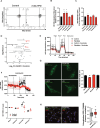This is a preprint.
An acute microglial metabolic response controls metabolism and improves memory
- PMID: 37066282
- PMCID: PMC10103996
- DOI: 10.1101/2023.04.03.535373
An acute microglial metabolic response controls metabolism and improves memory
Update in
-
An acute microglial metabolic response controls metabolism and improves memory.Elife. 2024 Dec 3;12:RP87120. doi: 10.7554/eLife.87120. Elife. 2024. PMID: 39625057 Free PMC article.
Abstract
Chronic high-fat feeding triggers chronic metabolic dysfunction including obesity, insulin resistance, and diabetes. How high-fat intake first triggers these pathophysiological states remains unknown. Here, we identify an acute microglial metabolic response that rapidly translates intake of high-fat diet (HFD) to a surprisingly beneficial effect on metabolism and spatial / learning memory. High-fat intake rapidly increases palmitate levels in cerebrospinal fluid and triggers a wave of microglial metabolic activation characterized by mitochondrial membrane activation and fission as well as metabolic skewing towards aerobic glycolysis. These effects are detectable throughout the brain and can be detected within as little as 12 hours of HFD exposure. In vivo, microglial ablation and conditional DRP1 deletion show that the microglial metabolic response is necessary for the acute effects of HFD. 13C-tracing experiments reveal that in addition to processing via β-oxidation, microglia shunt a substantial fraction of palmitate towards anaplerosis and re-release of bioenergetic carbons into the extracellular milieu in the form of lactate, glutamate, succinate, and intriguingly, the neuro-protective metabolite itaconate. Together, these data identify microglia as a critical nutrient regulatory node in the brain, metabolizing away harmful fatty acids and releasing the same carbons as alternate bioenergetic and protective substrates for surrounding cells. The data identify a surprisingly beneficial effect of short-term HFD on learning and memory.
Figures





References
-
- Kleinridders A., Konner A.C., and Bruning J.C., CNS-targets in control of energy and glucose homeostasis. Curr Opin Pharmacol, 2009. 9(6): p. 794–804. - PubMed
-
- Argente-Arizon P., et al., Glial cells and energy balance. J Mol Endocrinol, 2017. 58(1): p. R59–R71. - PubMed
-
- Pellerin L., et al., Evidence supporting the existence of an activity-dependent astrocyte-neuron lactate shuttle. Dev Neurosci, 1998. 20(4–5): p. 291–9. - PubMed
-
- Magistretti P.J. and Allaman I., Lactate in the brain: from metabolic end-product to signalling molecule. Nat Rev Neurosci, 2018. 19(4): p. 235–249. - PubMed
Publication types
Grants and funding
LinkOut - more resources
Full Text Sources
Molecular Biology Databases
Miscellaneous
